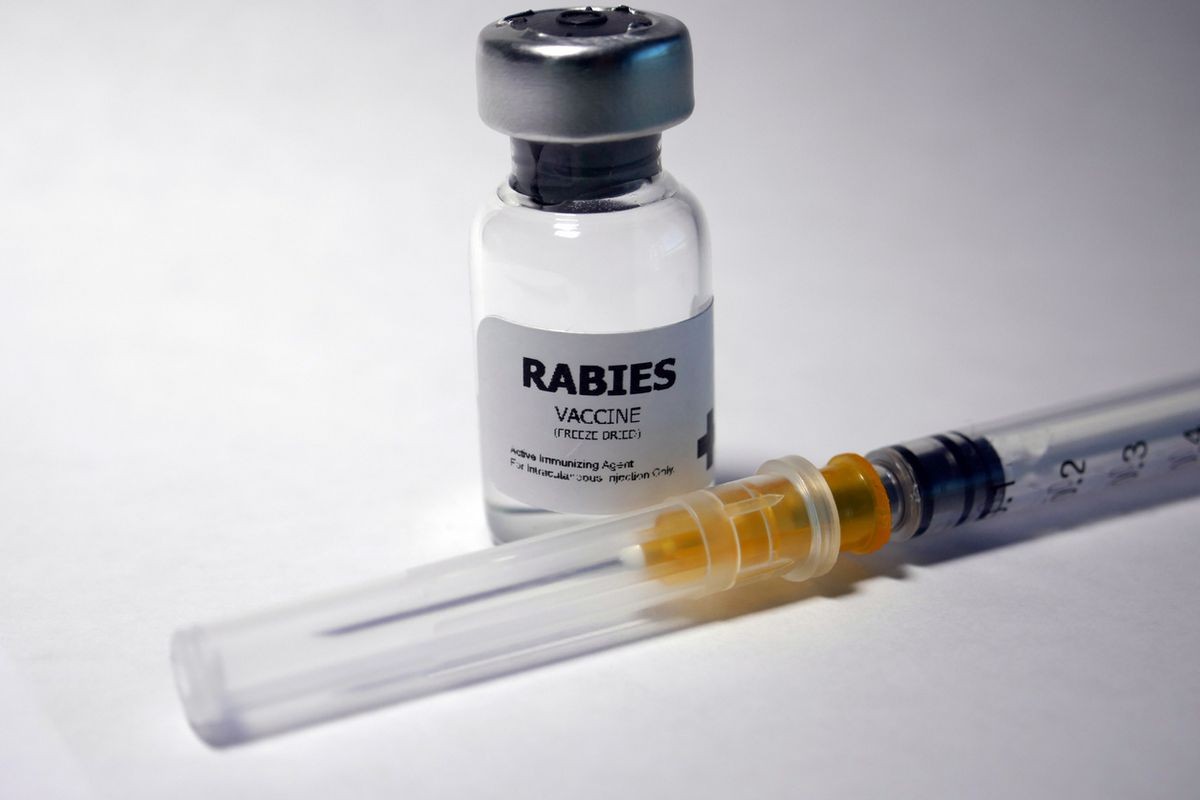
Contents
Rabies Vaccine
Rabies virus is transmitted by bites or scratches from infected animals, most commonly dogs, and also bats, cats, raccoons, foxes, and many other wild animals. The rabies vaccine is used as prophylaxis in individuals at high risk, such as veterinarians and lab workers handling live rabies virus.
Preexposure rabies vaccination, with a booster, can provide protection for up to 2 years, and one study showed the presence of antibodies even after 5 years. Postexposure vaccination may offer protection for up to 6 months. The purpose of postexposure vaccination is to prevent full-blown rabies infection and it is given in combination with human rabies immunoglobulin (HRIG), which are lab-grown rabies antibodies.
Rabies vaccine is an inactivated vaccine, composed of dead, purified virus material. The vaccine introduces harmless virus particles into the body, which cannot cause disease. It stimulates the immune system to produce antibodies against the virus, which can eliminate the rabies virus in the event of future exposure. It takes 7-10 days after immunization for the rabies antibodies to develop.
The rabies virus is cultured in laboratories using a medium such as human diploid cells, purified chick embryo cells, or purified vero cells, a cell line extracted from African green monkey kidney cells. The virus is harvested from these cultures, inactivated, and purified to prepare the vaccine. The vaccine may also contain substances to preserve and stabilize it, and enhance the immune response.
Warnings
- Rabies vaccine should not be administered as preexposure prophylaxis to individuals with known life-threatening hypersensitivity to the vaccine or any of its components, including neomycin.
- Vaccination may not provide 100% protection.
- Points to note regarding rabies vaccine administration include:
- The vaccine should not be injected into the gluteal area, as it may result in a lower response.
- The product is provided in a single dose and should not be used as a multidose vial for intradermal injection.
- In both pre-exposure and postexposure immunization, the full 1.0 mL dose should be given intramuscularly.
Side Effects of Rabies Vaccine
Common side effects of rabies vaccine include:
- Dizziness
- Headache
- Malaise
- Myalgia
- Nausea
- Abdominal pain
- Injection site reactions including itching, pain, swelling, redness, and hematoma
Less common side effects of rabies vaccine include hypersensitivity reactions such as allergic dermatitis, hives, pruritus, edema, and anaphylaxis.
Rare side effects of rabies vaccine include abnormal skin sensation, Guillain-Barre syndrome, encephalitis, meningitis, myelitis, multiple sclerosis, neuropathy, retrobulbar neuritis, seizures, vertigo, paralysis, cardiovascular toxicity, and palpitations.
This is not a complete list of all possible side effects or adverse reactions. Consult your doctor for medical advice about serious side effects or adverse reactions. You may also report side effects or health problems to the FDA at 1-800-FDA-1088.
Dosages of Rabies Vaccine
Injection, Freeze-Dried Suspension
Adult and pediatric:
Rabies Preexposure Immunization
Vaccination is recommended for children living in or visiting countries where exposure to rabid animals is a constant threat; worldwide statistics indicate children are more at risk than adults.
- 1 mL intramuscular (IM) in the deltoid region (in small children and infants, anterolateral region of thigh) x 3 doses
- Administer on days 0, 7, and 21 or 28
- 1 mL IM (deltoid region) to maintain a serum titer greater than 1:5 serum dilution by RFFIT
Frequency for testing serum titers:
- Test serum for rabies antibodies every 6 months in persons working with live rabies virus in research laboratories and vaccine production facilities (continuous risk category)
- Other laboratory workers (e.g., those performing rabies diagnostic testing), cavers, veterinarians and staff, animal-control and wildlife officers in enzootic rabies areas, and bat handlers regardless of location
- If titer is inadequate, administer a single booster dose of vaccine
- Veterinarians, veterinary students, and terrestrial animal-control and wildlife officers, working in low rabies endemicity areas and certain at-risk international travelers who have completed a full preexposure vaccination series with licensed vaccines and according to schedule, do not require routine booster serologic verification of detectable antibody titers or routine preexposure booster doses of vaccine
Rabies Postexposure Immunization
- 1 mL IM x 5 doses
- Administer on days 0, 3, 7, 14, and 28 in conjunction with administration of human rabies immune globulin (HRIG) on day 0
- HRIG: 20 IU/kg; if anatomically feasible, infiltrate the full dose around and into the wound(s), and administer any remaining volume IM at a distant site from the vaccine administration site
Previously immunized individuals:
- 1 mL IM x 2 doses on days 0 and 3
Drug Interactions with Rabies Vaccine
Inform your doctor of all medications you are currently taking, and they can advise you on any possible drug interactions. Do not begin taking, discontinue, or change the dosage of any medication without your doctor’s recommendation.
- Severe interactions of rabies vaccine include belimumab, certolizumab pegol, cyclosporine, ibrutinib, ifosfamide, lomustine, mechlorethamine, melphalan, mercaptopurine, methotrexate, onasemnogene abeparvovec, oxaliplatin, ponesimod, procarbazine, rabies immune globulin, human (RIG), rituximab, rituximab-hyaluronidase, tralokinumab, ustekinumab, and voclosporin, chloroquine, and ozanimod.
The drug interactions listed above are not all possible interactions or adverse effects. For more information on drug interactions, visit the RxList Drug Interaction Checker.
Always inform your doctor, pharmacist, or healthcare provider of all prescription and over-the-counter medications you use and their dosages, and keep a list of this information. Consult your doctor or healthcare provider if you have any questions about the medication.
By clicking Submit, I agree to the MedicineNet’s Terms & Conditions & Privacy Policy and understand that I may opt out of MedicineNet’s subscriptions at any time.
Pregnancy and Breastfeeding
- No animal reproduction studies have been conducted, and it is unknown if rabies vaccine can affect reproductive capacity or cause fetal harm if administered during pregnancy. Administer to pregnant women only if the benefits outweigh the risks, although if there is a substantial risk of rabies exposure, rabies vaccine may be administered to pregnant women as preexposure prophylaxis.
- Rabies is a deadly disease, and due to the potential consequences of inadequately treated rabies exposure and limited data indicating no fetal abnormalities associated with rabies vaccination, pregnant women should receive rabies vaccine postexposure.
- It is unknown whether rabies vaccine is present in human milk, as many drugs are excreted in human milk. Rabies vaccine should be administered with caution in nursing mothers.
Additional Information about Rabies Vaccine
- Rabies is a lethal disease, and the vaccine is recommended for individuals who have a potential risk of contracting it.
- Consult with your healthcare provider for rabies vaccination if:
- You are bitten or scratched by a rabid wild or pet animal, or a pet animal whose rabies vaccination status is unknown.
- You have reason to believe an open wound or mucous membrane has come into contact with the saliva of a rabid animal or an animal whose immunization status is unknown.
From
Parenting Resources
Featured Centers
- What Are the Best PsA Treatments for You?
- Understanding Biologics
- 10 Things People With Depression Wish You Knew
Summary
The rabies vaccine is a viral vaccine administered to prevent or treat rabies, a lethal infectious disease that affects the nervous system. Common side effects of the rabies vaccine include dizziness, headache, malaise, myalgia, nausea, and abdominal pain. Consult your doctor if pregnant or breastfeeding. Consult with your healthcare provider for rabies vaccination if you are bitten or scratched by a rabid wild or pet animal, or a pet animal whose rabies vaccination status is unknown.


